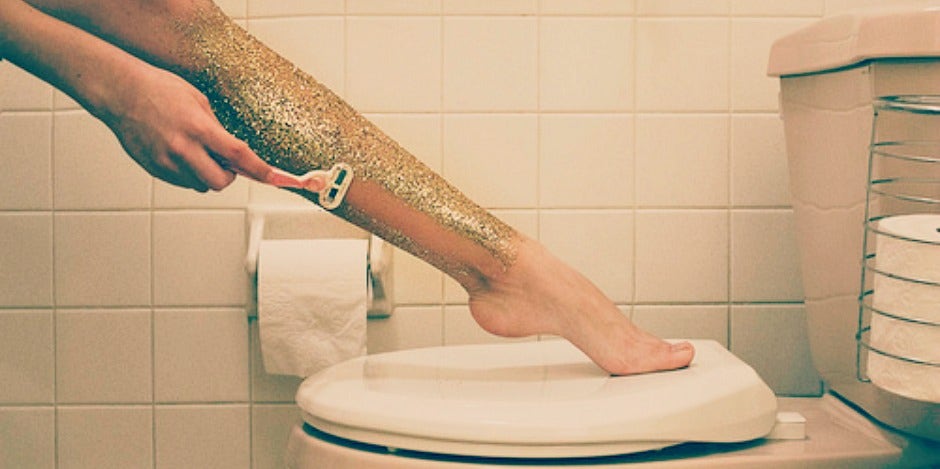10 Hair Removal Questions You're DYING To Ask — Answered By A Pro
Summer's here! And body hair can be SUCH a bummer ...
 WeHeartIt
WeHeartIt YourTango sat down for some beauty tips smooth talk with Normajean Fusco, hair removal expert and founder of Nufree — a self preserving antibacterial, antimicrobial alternative to waxing that will leave you smooth and hairless with less mess and virtually no pain.
Here are her answers to your top ten questions about how to be smooth and sexy this summer:
1. What can you use to treat ingrown hairs?
Gentle is always better. Keep the surface of the affected area of the skin clean and moisturized. Wash this area using a nylon powder puff. Apply an antiseptic such as Finipil daily to moisturize and keep the area cool and clean.
2. Are there any online resources you can recommend for finding a trusted hair removal technician?
It's important to do your research when selecting a hair removal technician. Be sure you are choosing a licensed professional. Nufree.com has a section for finding a registered salon in your area — they use all the appropriate products and follow the manufacturers' procedures and sanitary rules.
3. How do you decide if hair removal is safe for you?
It depends on what part of the body you wish to have done, and whether you are using any products at home that may interfere with the hair removal process for that area. If your physician has advised against epilation because of certain surgeries, or if you're on an oral medication that thins your skin, you may not be a good candidate for hair removal.
4. Does hair removal make hair grow back thicker?
When you shave or dissolve hair with a depilatory cream, the thinner part of the hair on the surface is gone, and the widest part of the hair, which is normally at the root, reaches the surface, so it can appear darker and thicker. As you continue to do this, the wider part of the hair appears at the surface. Hairs can become coarser and look darker as time goes on.
5. Why do I get shaving bumps?
A razor bump is actually irritation of the sebaceous gland, which is attached to the hair follicle. As the irritation of the skin builds up, it causes a blockage of the follicle opening, which can cause ingrown hairs. If the follicle walls are distorted enough, or if the follicle is blocked by dead skin or some outside comedogenic (pore clogger) such as broken hairs, powders or dry skin, the flow of sebaceous oils can build up, causing what is known as a razor bump.
6. How should I prepare for bikini hair removal?
Do not over exfoliate your skin. You don’t want to disturb the natural pH of the skin, or irritate it in any way. Do not apply any lotions or creams beforehand for the same reason. You should make sure that the hair is long enough for the procedure (1/8-1/4 inch long for best results). Simply cleanse your skin with liquid body shampoo or soap in the shower or bath. I recommend a hydrating, gentle liquid body wash such as Moisturebal concentrate — one drop goes a long way keeping skin fresh and clean even in hard water.
7. What alternatives are there to traditional waxing?
Nufree is a hair-removal system which is similar to waxing, but it does not contain wax, honey or sugar, and is a self preserving antibacterial and antimicrobial. It's made of a proprietary combination of anhydrous (waterless) soya and soya products. It cannot be absorbed by the skin and does not have the sticky consistency of wax, which makes this hair removal process virtually painless. It's applied thinner than wax, and uses a special strip to remove the hair but doesn't stick to your skin.
8. Are all hair removal procedures safe?
I've seen the most issues arise from waxes or hair removal procedures that require high temperatures. Hot waxes should not be used on sensitive areas and should not be reapplied — that's how mistakes happen. NuFree is self-preserving at low temperatures, which is why it is my preferred method of hair removal. Finipil antiseptic insures the safety of the area and cools so quickly it makes the procedure very comfortable.
I also wouldn't recommend at-home hair removal procedures, particularly those using electric appliances or chemicals. They can be mismanaged causing burns (and you'd have to be a contortionist to do certain body areas correctly).
Furthermore, certain medications or skin cleansing products may affect the hair removal procedure you use. Every good professional should ask you about that, prior to starting a hair removal service.
9. Do you recommend I tan or spray tan before getting hair removal, or should I do the hair removal first?
Hair removal then tan. Never spray or suntan first. You could dehydrate or clog the hairs and the result won't be a the smooth/hydrated look we all strive for. However, you can suntan or spray tan immediately after using NuFree because it works by sticking to the hair oils, not the skin. An antiseptic lotion like Finipil is applied after the hair removal instantly cooling and protecting the skin, making it acceptable for tanning or makeup.
With traditional waxing and certain depilatories, you should wait at least 36 to 72 hours before tanning since you don't know how the skin was affected.
10. Should I do all my body hair removal at once?
After having some smaller areas done, discuss the timing with your professional. If you are comfortable with the smaller areas, your professional will book you accordingly.

